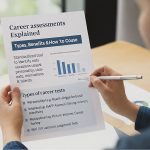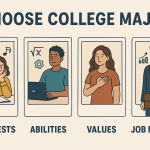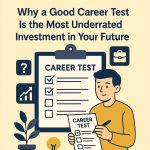Career News
What Can a Personality Test Reveal About Your Career Path?

Introduction: Why Your Job Personality Test Matters More Than a Résumé
Most professionals spend hours polishing their résumés, LinkedIn summaries, and cover letters. Yet fewer invest even thirty minutes in understanding the one document that governs every career decision they’ll ever make: their own personality profile. A Job Personality Test is not a toy quiz or feel-good horoscope; when designed and interpreted correctly, it acts as a data-driven compass that points you toward work environments, roles, and leadership styles where you’ll thrive.
I will attempt to explain:
- How a scientifically validated personality assessment is built
- What specific traits predict job satisfaction, performance, and burnout risk
- How employers use personality data in hiring and talent development
- A five-step action plan to translate test results into tangible career moves
Whether you’re a new graduate hunting for direction or a seasoned executive craving reinvention, a Job Personality Test can highlight your natural strengths, motivational hot buttons, and hidden derailers long before an expensive misstep forces you to learn them the hard way.
- The Science Behind Job Personality Tests
1.1 From Trait Theory to Predictive Analytics
Personality psychology rests on a century of empirical research, culminating in trait-based models such as the MAPP (Motivational Appraisal of Personal Potential), Big Five/OCEAN, Holland Codes (RIASEC), and DISC. Modern job-specific instruments expand on these frameworks by adding competency libraries, gamified scenarios, and machine-learning scoring. A robust Job Personality Test will typically demonstrate:
- Reliability – You’d score roughly the same if you retook the test next week under similar conditions.
- Validity – The test actually measures what it claims to (e.g., “detail orientation” rather than reading speed).
- Predictive power – Scores correlate with on-the-job outcomes like quota attainment, project completion rate, or turnover.
1.2 Trait Clusters Most Relevant to Careers
| Trait Domain | Why Recruiters Care | Example Indicators |
| Extraversion vs. Introversion | Influences client-facing success, leadership visibility | Networking comfort, presentation energy |
| Conscientiousness | Predicts reliability, deadline adherence, ethical behavior | Task follow-through, systemization |
| Openness to Experience | Signals innovation potential and change agility | Idea generation, appetite for risk |
| Emotional Stability | Linked to resilience under pressure | Stress recovery time, conflict tolerance |
| Agreeableness | Affects team cohesion, customer satisfaction | Empathy, negotiating style |
- What a Job Personality Test Can Reveal About You
2.1 Optimal Role Archetypes
High-scoring analytical introverts may shine in data science or financial risk. Creative extroverts might flourish in product evangelism or UX research. The test helps you benchmark your own pattern against occupational archetypes, saving months—or years—of trial-and-error transfers.
2.2 Preferred Work Environments
Are you energized by constant collaboration or drained by open-plan chatter? Some Job Personality Tests overlay trait data onto environmental factors—such as autonomy level, pace of change, and feedback frequency—to flag “culture fits” before you sign the offer letter.
2.3 Intrinsic Motivators and Potential Burnout Triggers
A top-tier instrument will highlight intrinsic motivators (recognition, mastery, purpose) and early-warning burnout triggers (micromanagement, isolation, monotonous tasks). That actionable insight empowers you to negotiate role design, request sabbaticals, or seek targeted mentoring.
2.4 Leadership DNA and Derailers
Your personality profile identifies not only your leadership ceiling but also possible derailers e.g., high Dominance can drive results yet risk authoritarian behavior under stress. Knowing these blind spots lets you craft a personal development plan before stakeholders feel the impact.
- How Employers Use Job Personality Tests
- Pre-hire Screening – Many applicant-tracking systems integrate quick-fit personality screeners to filter high-volume roles without introducing bias around age, gender, or academic pedigree.
- Succession Planning – HR business partners overlay team composites to reveal gaps in strategic thinking or diversity of thought.
- Conflict Resolution – Mediators leverage assessment data to frame disagreements as style clashes rather than personal flaws.
- Training ROI Measurement – Post-training personality shifts (e.g., rise in emotional-intelligence facets) serve as leading indicators of program impact.
Be aware: reputable organizations use Job Personality Tests as one data point, not a hiring veto. Transparency and candidate opt-in are best practice.
- Five-Step Action Plan to Leverage Your Results
Step 1 – Choose a Validated Test
Look for norms, technical manuals, and evidence of peer-reviewed studies. Free pop-quizzes are fun but seldom accurate enough for career investment.
Step 2 – Reflect, Don’t React
Block one hour of uninterrupted time to read the narrative report. Jot initial “aha” moments and potential doubts; both are clues.
Step 3 – Map Traits to Daily Behaviors
If your profile says you thrive on autonomy, audit your current calendar. How many decisions do you make independently versus after committee approval?
Step 4 – Align Results with Career Goals
Turn insight into strategy:
| Insight | Possible Action |
| High Openness + Low Conscientiousness | Seek roles with idea generation but hire a detail-oriented partner. |
| High Emotional Stability + Moderate Extraversion | Volunteer for crisis-response projects requiring calm communication. |
| Low Agreeableness + High Analytical | Research roles in forensic auditing or data forensic where skepticism is vital. |
Step 5 – Schedule a 90-Day Review
Traits are stable, but behavior changes stick only with reinforcement. Revisit your action plan quarterly; adjust goals as real-world feedback rolls in.
- Common Myths That Derail Progress
- “Personality tests pigeonhole me.”
Science shows core traits are stable but not deterministic; they highlight natural advantage zones—talent is still cultivated. - “Employers misuse the data.”
Ethical guidelines and legislation (EEOC, GDPR) protect candidates. Choose organizations that share the report and invite dialogue. - “All assessments are alike.”
Tools vary in reliability; DISC (behavior) differs from Big Five (traits) or Motivational assessments (drivers). Select tests aligned with your goal.
- Choosing the Right Job Personality Test Platform
When evaluating platforms:
- Transparency – Clear documentation of methodology and scoring.
- Actionable Reports – Beyond scores: development tips, coaching questions, role fits.
- Data Control – User-owned data with export/share settings, GDPR compliance.
- Marketplace Ecosystem – Ability to stack multiple assessments (e.g., cognitive + EQ) for 360-degree self-awareness.
- Integration Hooks – API or downloadable PDFs for recruiters, coaches, and LMS systems.
Conclusion: Your Personality Is the Career Asset You’ve Overlooked
A Job Personality Test is far more than an HR fad; it is a scientifically grounded lens into the work contexts where you can deliver your best performance and sustain long-term wellbeing. When combined with reflection and intentional planning, your trait profile becomes a living roadmap—guiding job searches, optimizing current roles, and even preventing burnout before it strikes.
Stop guessing whether the next big opportunity is right for you. Take a validated Job Personality Test, decode the insights, and let your data-backed compass lead you to a career path where you don’t just succeed you thrive.





